Qantas Brand Management: Brand Equity, Measurement & Growth Plan
VerifiedAdded on 2023/06/11
|20
|4709
|328
Report
AI Summary
This report provides a comprehensive analysis of Qantas Airways' brand management strategies, focusing on brand equity and growth. It employs several models, including the Customer-Based Brand Equity (CBBE) model, Brand Dynamics, Equity Engine, and Young and Rubicam's Brand Asset Valuator, to assess Qantas' brand presence, relevance, performance, and advantages. The report also explores different approaches to measure brand equity performance, such as the Brand Basic Comparative Approach, Marketing-Based Approach, Conjoint Analysis, Residual Approach, and Valuation Approach. Furthermore, it discusses Ansoff Matrix growth strategies, including market penetration, market development, product development, and diversification, to identify potential avenues for Qantas to expand its business. The analysis aims to provide insights into how Qantas can maintain its market position and enhance its brand image through effective brand management practices.
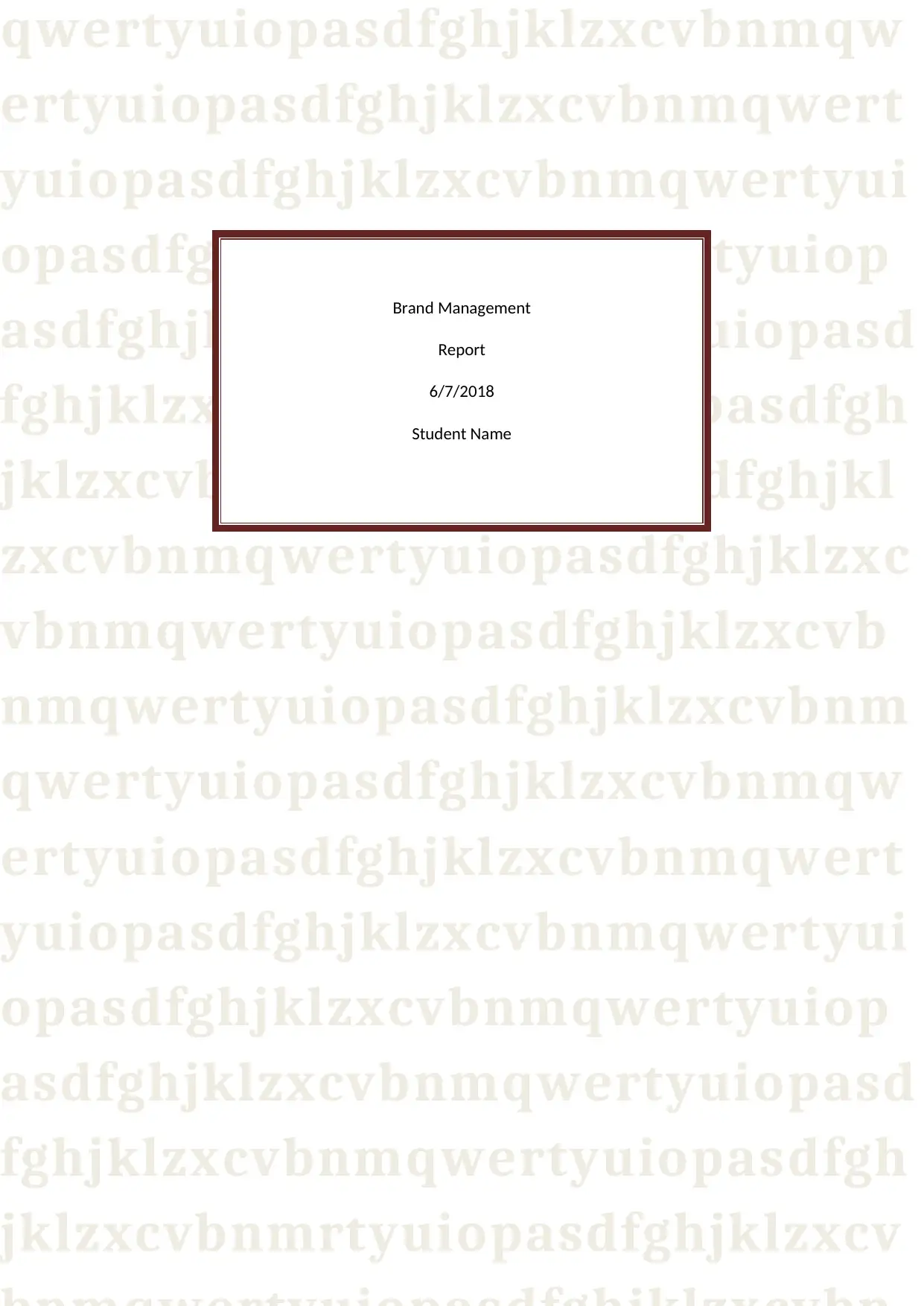
qwertyuiopasdfghjklzxcvbnmqw
ertyuiopasdfghjklzxcvbnmqwert
yuiopasdfghjklzxcvbnmqwertyui
opasdfghjklzxcvbnmqwertyuiop
asdfghjklzxcvbnmqwertyuiopasd
fghjklzxcvbnmqwertyuiopasdfgh
jklzxcvbnmqwertyuiopasdfghjkl
zxcvbnmqwertyuiopasdfghjklzxc
vbnmqwertyuiopasdfghjklzxcvb
nmqwertyuiopasdfghjklzxcvbnm
qwertyuiopasdfghjklzxcvbnmqw
ertyuiopasdfghjklzxcvbnmqwert
yuiopasdfghjklzxcvbnmqwertyui
opasdfghjklzxcvbnmqwertyuiop
asdfghjklzxcvbnmqwertyuiopasd
fghjklzxcvbnmqwertyuiopasdfgh
jklzxcvbnmrtyuiopasdfghjklzxcv
Brand Management
Report
6/7/2018
Student Name
ertyuiopasdfghjklzxcvbnmqwert
yuiopasdfghjklzxcvbnmqwertyui
opasdfghjklzxcvbnmqwertyuiop
asdfghjklzxcvbnmqwertyuiopasd
fghjklzxcvbnmqwertyuiopasdfgh
jklzxcvbnmqwertyuiopasdfghjkl
zxcvbnmqwertyuiopasdfghjklzxc
vbnmqwertyuiopasdfghjklzxcvb
nmqwertyuiopasdfghjklzxcvbnm
qwertyuiopasdfghjklzxcvbnmqw
ertyuiopasdfghjklzxcvbnmqwert
yuiopasdfghjklzxcvbnmqwertyui
opasdfghjklzxcvbnmqwertyuiop
asdfghjklzxcvbnmqwertyuiopasd
fghjklzxcvbnmqwertyuiopasdfgh
jklzxcvbnmrtyuiopasdfghjklzxcv
Brand Management
Report
6/7/2018
Student Name
Paraphrase This Document
Need a fresh take? Get an instant paraphrase of this document with our AI Paraphraser
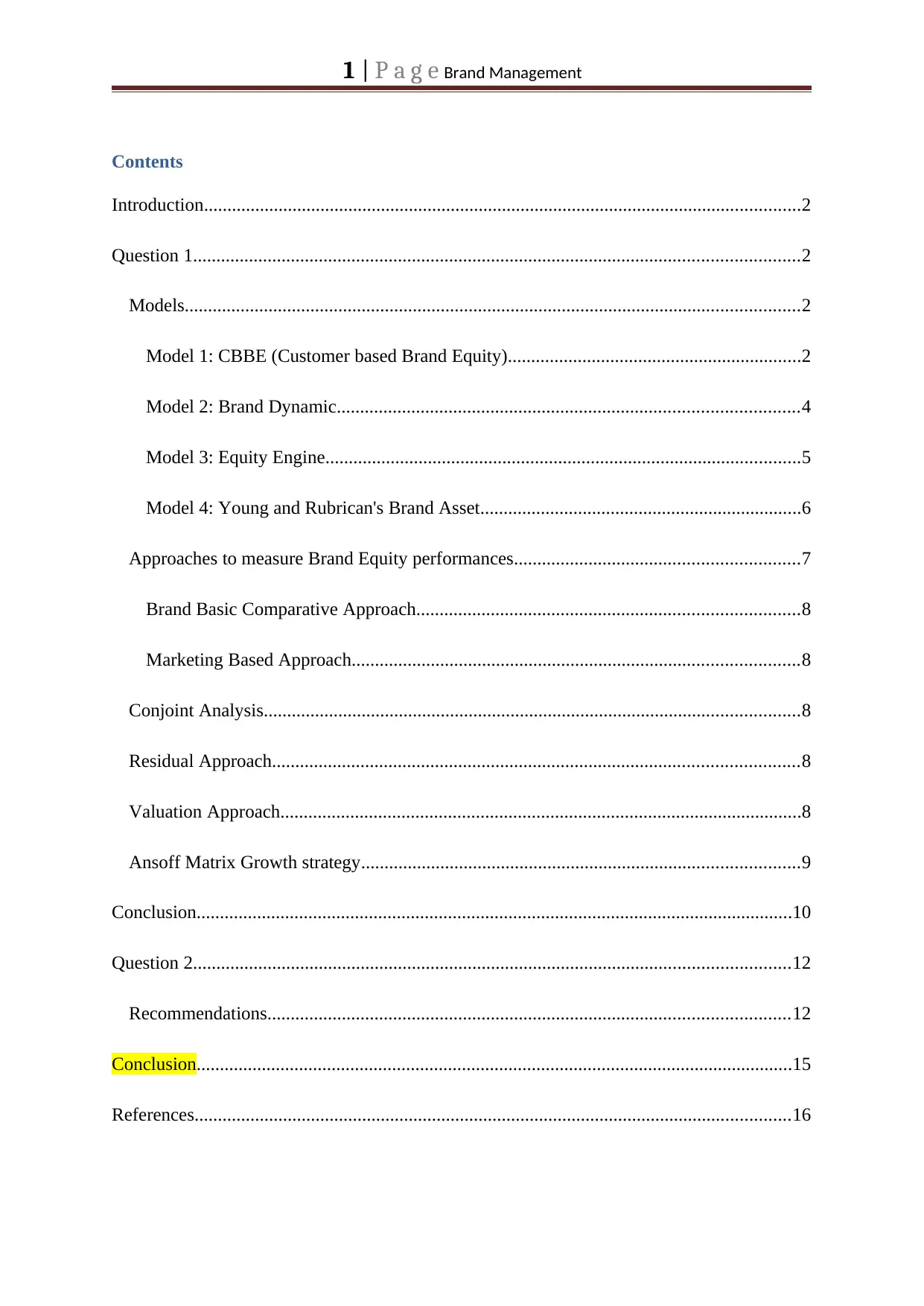
1 | P a g e Brand Management
Contents
Introduction................................................................................................................................2
Question 1..................................................................................................................................2
Models....................................................................................................................................2
Model 1: CBBE (Customer based Brand Equity)...............................................................2
Model 2: Brand Dynamic...................................................................................................4
Model 3: Equity Engine......................................................................................................5
Model 4: Young and Rubrican's Brand Asset.....................................................................6
Approaches to measure Brand Equity performances.............................................................7
Brand Basic Comparative Approach..................................................................................8
Marketing Based Approach................................................................................................8
Conjoint Analysis...................................................................................................................8
Residual Approach.................................................................................................................8
Valuation Approach................................................................................................................8
Ansoff Matrix Growth strategy..............................................................................................9
Conclusion................................................................................................................................10
Question 2................................................................................................................................12
Recommendations................................................................................................................12
Conclusion................................................................................................................................15
References................................................................................................................................16
Contents
Introduction................................................................................................................................2
Question 1..................................................................................................................................2
Models....................................................................................................................................2
Model 1: CBBE (Customer based Brand Equity)...............................................................2
Model 2: Brand Dynamic...................................................................................................4
Model 3: Equity Engine......................................................................................................5
Model 4: Young and Rubrican's Brand Asset.....................................................................6
Approaches to measure Brand Equity performances.............................................................7
Brand Basic Comparative Approach..................................................................................8
Marketing Based Approach................................................................................................8
Conjoint Analysis...................................................................................................................8
Residual Approach.................................................................................................................8
Valuation Approach................................................................................................................8
Ansoff Matrix Growth strategy..............................................................................................9
Conclusion................................................................................................................................10
Question 2................................................................................................................................12
Recommendations................................................................................................................12
Conclusion................................................................................................................................15
References................................................................................................................................16
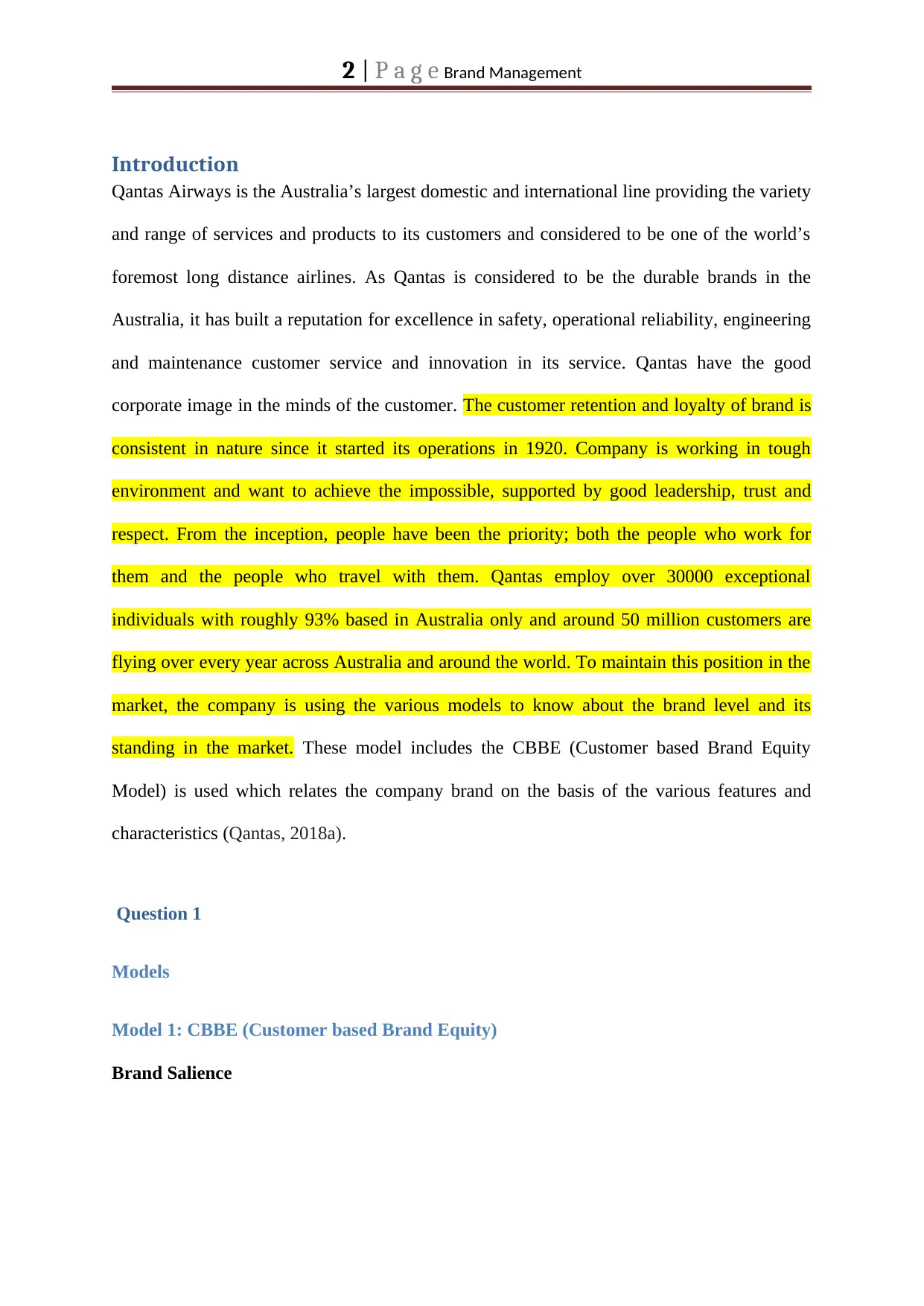
2 | P a g e Brand Management
Introduction
Qantas Airways is the Australia’s largest domestic and international line providing the variety
and range of services and products to its customers and considered to be one of the world’s
foremost long distance airlines. As Qantas is considered to be the durable brands in the
Australia, it has built a reputation for excellence in safety, operational reliability, engineering
and maintenance customer service and innovation in its service. Qantas have the good
corporate image in the minds of the customer. The customer retention and loyalty of brand is
consistent in nature since it started its operations in 1920. Company is working in tough
environment and want to achieve the impossible, supported by good leadership, trust and
respect. From the inception, people have been the priority; both the people who work for
them and the people who travel with them. Qantas employ over 30000 exceptional
individuals with roughly 93% based in Australia only and around 50 million customers are
flying over every year across Australia and around the world. To maintain this position in the
market, the company is using the various models to know about the brand level and its
standing in the market. These model includes the CBBE (Customer based Brand Equity
Model) is used which relates the company brand on the basis of the various features and
characteristics (Qantas, 2018a).
Question 1
Models
Model 1: CBBE (Customer based Brand Equity)
Brand Salience
Introduction
Qantas Airways is the Australia’s largest domestic and international line providing the variety
and range of services and products to its customers and considered to be one of the world’s
foremost long distance airlines. As Qantas is considered to be the durable brands in the
Australia, it has built a reputation for excellence in safety, operational reliability, engineering
and maintenance customer service and innovation in its service. Qantas have the good
corporate image in the minds of the customer. The customer retention and loyalty of brand is
consistent in nature since it started its operations in 1920. Company is working in tough
environment and want to achieve the impossible, supported by good leadership, trust and
respect. From the inception, people have been the priority; both the people who work for
them and the people who travel with them. Qantas employ over 30000 exceptional
individuals with roughly 93% based in Australia only and around 50 million customers are
flying over every year across Australia and around the world. To maintain this position in the
market, the company is using the various models to know about the brand level and its
standing in the market. These model includes the CBBE (Customer based Brand Equity
Model) is used which relates the company brand on the basis of the various features and
characteristics (Qantas, 2018a).
Question 1
Models
Model 1: CBBE (Customer based Brand Equity)
Brand Salience
⊘ This is a preview!⊘
Do you want full access?
Subscribe today to unlock all pages.

Trusted by 1+ million students worldwide
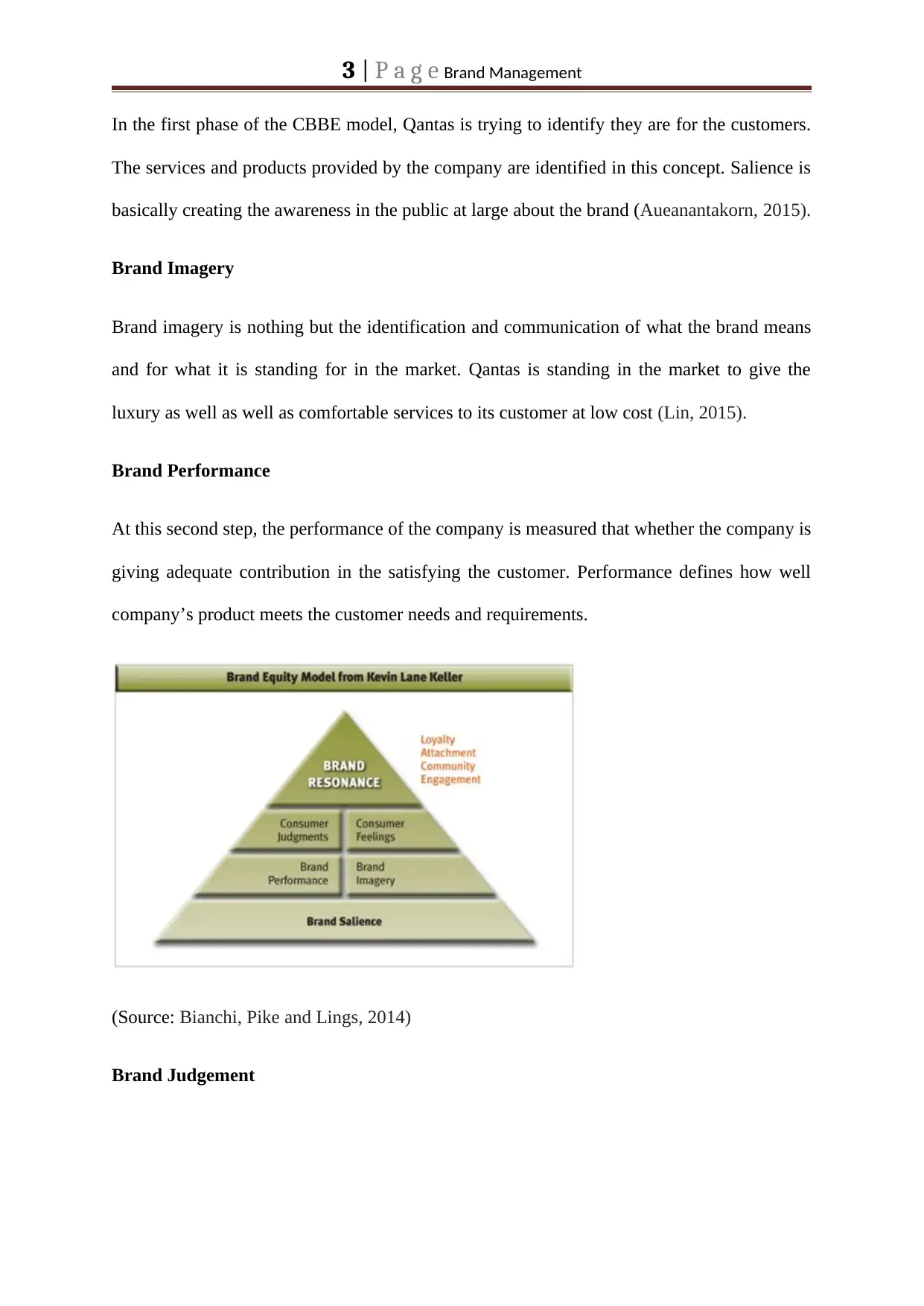
3 | P a g e Brand Management
In the first phase of the CBBE model, Qantas is trying to identify they are for the customers.
The services and products provided by the company are identified in this concept. Salience is
basically creating the awareness in the public at large about the brand (Aueanantakorn, 2015).
Brand Imagery
Brand imagery is nothing but the identification and communication of what the brand means
and for what it is standing for in the market. Qantas is standing in the market to give the
luxury as well as well as comfortable services to its customer at low cost (Lin, 2015).
Brand Performance
At this second step, the performance of the company is measured that whether the company is
giving adequate contribution in the satisfying the customer. Performance defines how well
company’s product meets the customer needs and requirements.
(Source: Bianchi, Pike and Lings, 2014)
Brand Judgement
In the first phase of the CBBE model, Qantas is trying to identify they are for the customers.
The services and products provided by the company are identified in this concept. Salience is
basically creating the awareness in the public at large about the brand (Aueanantakorn, 2015).
Brand Imagery
Brand imagery is nothing but the identification and communication of what the brand means
and for what it is standing for in the market. Qantas is standing in the market to give the
luxury as well as well as comfortable services to its customer at low cost (Lin, 2015).
Brand Performance
At this second step, the performance of the company is measured that whether the company is
giving adequate contribution in the satisfying the customer. Performance defines how well
company’s product meets the customer needs and requirements.
(Source: Bianchi, Pike and Lings, 2014)
Brand Judgement
Paraphrase This Document
Need a fresh take? Get an instant paraphrase of this document with our AI Paraphraser
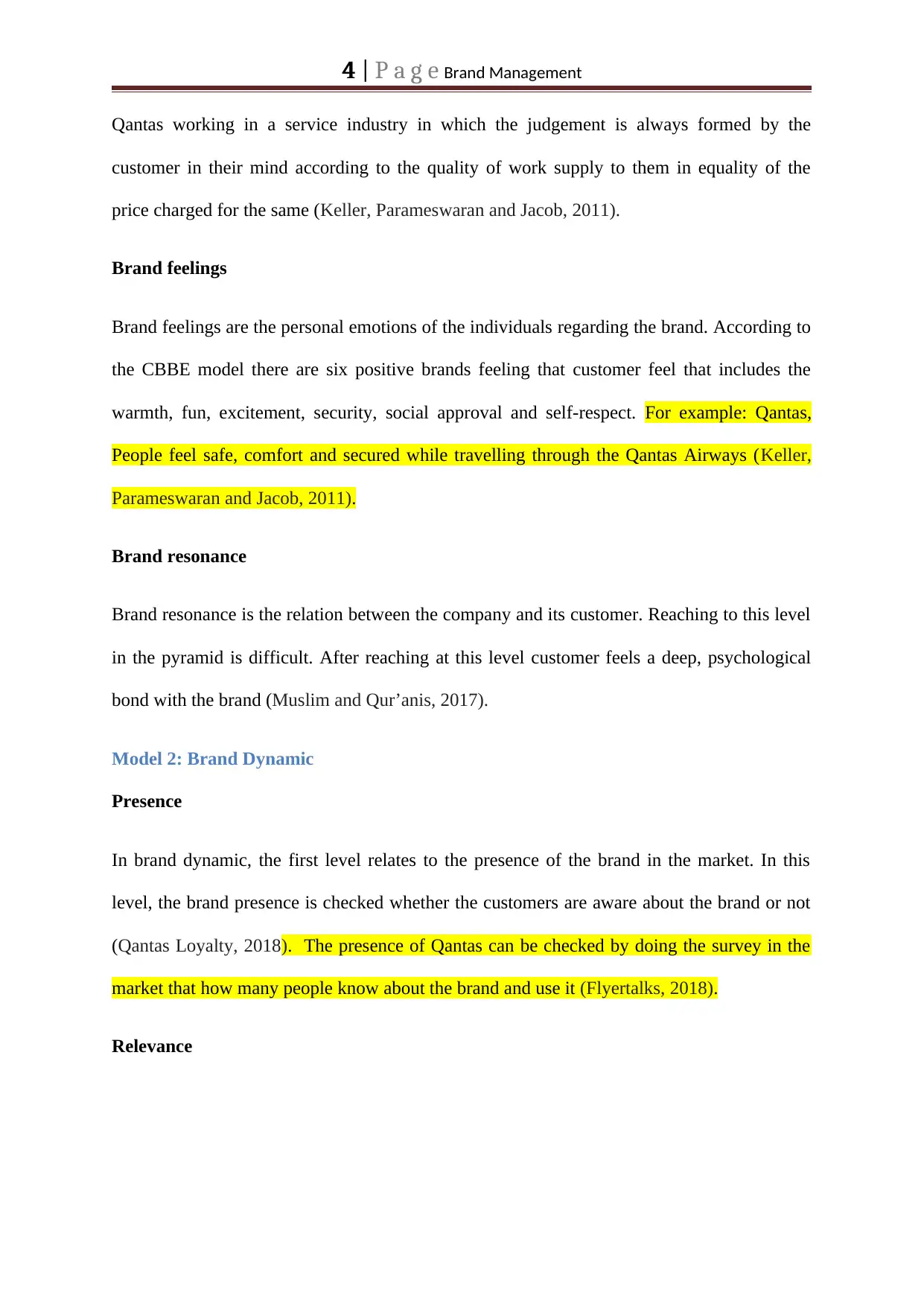
4 | P a g e Brand Management
Qantas working in a service industry in which the judgement is always formed by the
customer in their mind according to the quality of work supply to them in equality of the
price charged for the same (Keller, Parameswaran and Jacob, 2011).
Brand feelings
Brand feelings are the personal emotions of the individuals regarding the brand. According to
the CBBE model there are six positive brands feeling that customer feel that includes the
warmth, fun, excitement, security, social approval and self-respect. For example: Qantas,
People feel safe, comfort and secured while travelling through the Qantas Airways (Keller,
Parameswaran and Jacob, 2011).
Brand resonance
Brand resonance is the relation between the company and its customer. Reaching to this level
in the pyramid is difficult. After reaching at this level customer feels a deep, psychological
bond with the brand (Muslim and Qur’anis, 2017).
Model 2: Brand Dynamic
Presence
In brand dynamic, the first level relates to the presence of the brand in the market. In this
level, the brand presence is checked whether the customers are aware about the brand or not
(Qantas Loyalty, 2018). The presence of Qantas can be checked by doing the survey in the
market that how many people know about the brand and use it (Flyertalks, 2018).
Relevance
Qantas working in a service industry in which the judgement is always formed by the
customer in their mind according to the quality of work supply to them in equality of the
price charged for the same (Keller, Parameswaran and Jacob, 2011).
Brand feelings
Brand feelings are the personal emotions of the individuals regarding the brand. According to
the CBBE model there are six positive brands feeling that customer feel that includes the
warmth, fun, excitement, security, social approval and self-respect. For example: Qantas,
People feel safe, comfort and secured while travelling through the Qantas Airways (Keller,
Parameswaran and Jacob, 2011).
Brand resonance
Brand resonance is the relation between the company and its customer. Reaching to this level
in the pyramid is difficult. After reaching at this level customer feels a deep, psychological
bond with the brand (Muslim and Qur’anis, 2017).
Model 2: Brand Dynamic
Presence
In brand dynamic, the first level relates to the presence of the brand in the market. In this
level, the brand presence is checked whether the customers are aware about the brand or not
(Qantas Loyalty, 2018). The presence of Qantas can be checked by doing the survey in the
market that how many people know about the brand and use it (Flyertalks, 2018).
Relevance
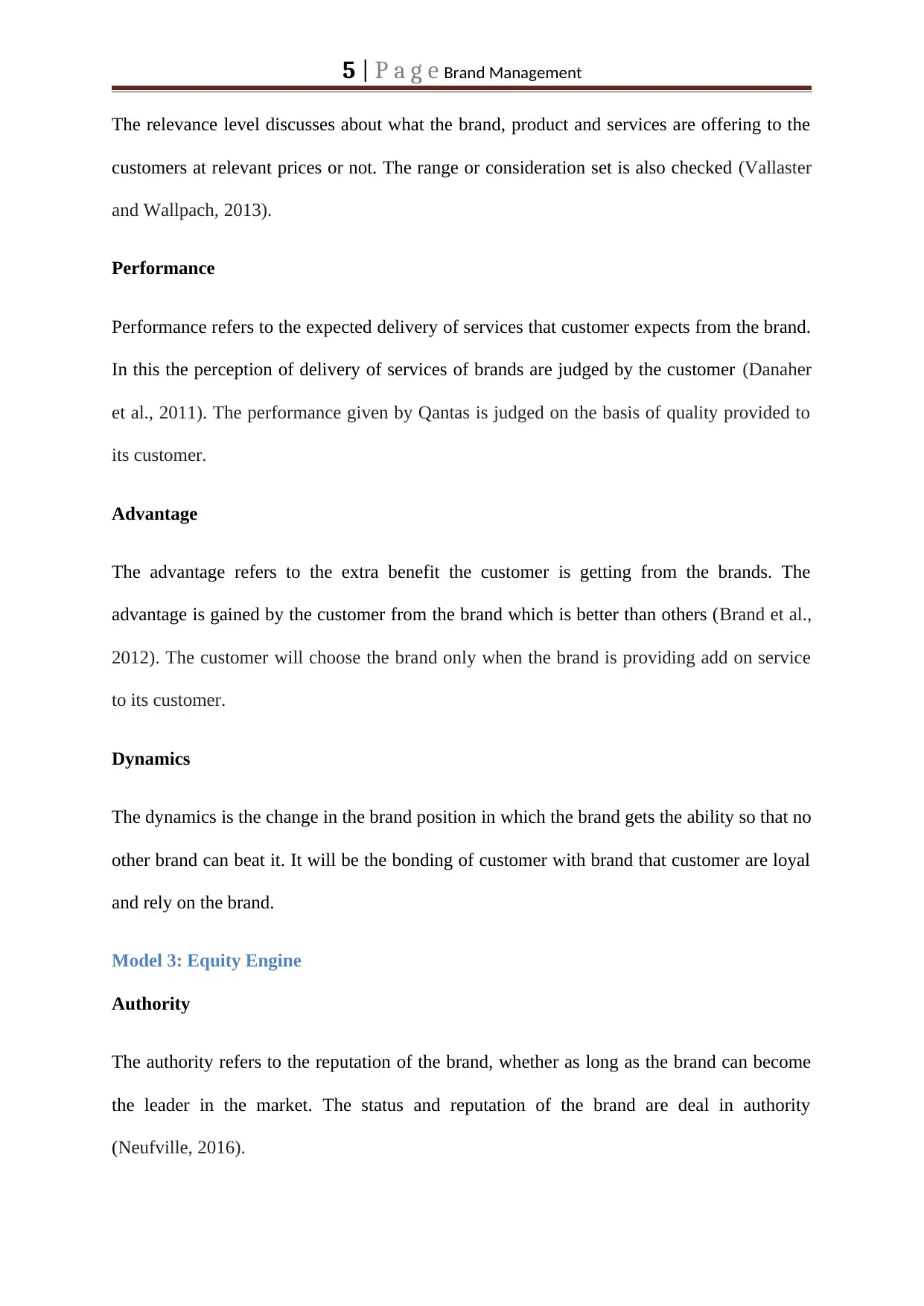
5 | P a g e Brand Management
The relevance level discusses about what the brand, product and services are offering to the
customers at relevant prices or not. The range or consideration set is also checked (Vallaster
and Wallpach, 2013).
Performance
Performance refers to the expected delivery of services that customer expects from the brand.
In this the perception of delivery of services of brands are judged by the customer (Danaher
et al., 2011). The performance given by Qantas is judged on the basis of quality provided to
its customer.
Advantage
The advantage refers to the extra benefit the customer is getting from the brands. The
advantage is gained by the customer from the brand which is better than others (Brand et al.,
2012). The customer will choose the brand only when the brand is providing add on service
to its customer.
Dynamics
The dynamics is the change in the brand position in which the brand gets the ability so that no
other brand can beat it. It will be the bonding of customer with brand that customer are loyal
and rely on the brand.
Model 3: Equity Engine
Authority
The authority refers to the reputation of the brand, whether as long as the brand can become
the leader in the market. The status and reputation of the brand are deal in authority
(Neufville, 2016).
The relevance level discusses about what the brand, product and services are offering to the
customers at relevant prices or not. The range or consideration set is also checked (Vallaster
and Wallpach, 2013).
Performance
Performance refers to the expected delivery of services that customer expects from the brand.
In this the perception of delivery of services of brands are judged by the customer (Danaher
et al., 2011). The performance given by Qantas is judged on the basis of quality provided to
its customer.
Advantage
The advantage refers to the extra benefit the customer is getting from the brands. The
advantage is gained by the customer from the brand which is better than others (Brand et al.,
2012). The customer will choose the brand only when the brand is providing add on service
to its customer.
Dynamics
The dynamics is the change in the brand position in which the brand gets the ability so that no
other brand can beat it. It will be the bonding of customer with brand that customer are loyal
and rely on the brand.
Model 3: Equity Engine
Authority
The authority refers to the reputation of the brand, whether as long as the brand can become
the leader in the market. The status and reputation of the brand are deal in authority
(Neufville, 2016).
⊘ This is a preview!⊘
Do you want full access?
Subscribe today to unlock all pages.

Trusted by 1+ million students worldwide
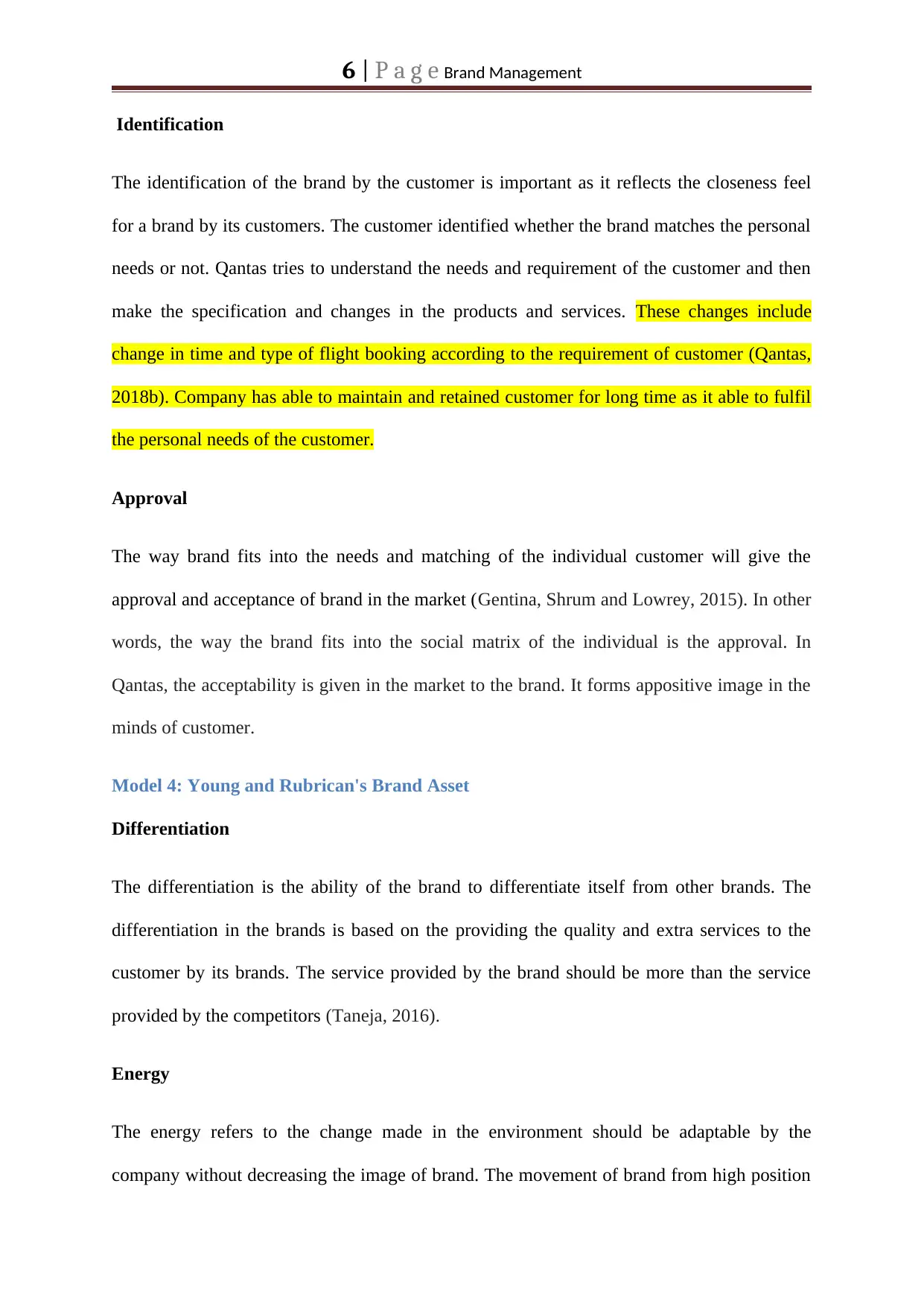
6 | P a g e Brand Management
Identification
The identification of the brand by the customer is important as it reflects the closeness feel
for a brand by its customers. The customer identified whether the brand matches the personal
needs or not. Qantas tries to understand the needs and requirement of the customer and then
make the specification and changes in the products and services. These changes include
change in time and type of flight booking according to the requirement of customer (Qantas,
2018b). Company has able to maintain and retained customer for long time as it able to fulfil
the personal needs of the customer.
Approval
The way brand fits into the needs and matching of the individual customer will give the
approval and acceptance of brand in the market (Gentina, Shrum and Lowrey, 2015). In other
words, the way the brand fits into the social matrix of the individual is the approval. In
Qantas, the acceptability is given in the market to the brand. It forms appositive image in the
minds of customer.
Model 4: Young and Rubrican's Brand Asset
Differentiation
The differentiation is the ability of the brand to differentiate itself from other brands. The
differentiation in the brands is based on the providing the quality and extra services to the
customer by its brands. The service provided by the brand should be more than the service
provided by the competitors (Taneja, 2016).
Energy
The energy refers to the change made in the environment should be adaptable by the
company without decreasing the image of brand. The movement of brand from high position
Identification
The identification of the brand by the customer is important as it reflects the closeness feel
for a brand by its customers. The customer identified whether the brand matches the personal
needs or not. Qantas tries to understand the needs and requirement of the customer and then
make the specification and changes in the products and services. These changes include
change in time and type of flight booking according to the requirement of customer (Qantas,
2018b). Company has able to maintain and retained customer for long time as it able to fulfil
the personal needs of the customer.
Approval
The way brand fits into the needs and matching of the individual customer will give the
approval and acceptance of brand in the market (Gentina, Shrum and Lowrey, 2015). In other
words, the way the brand fits into the social matrix of the individual is the approval. In
Qantas, the acceptability is given in the market to the brand. It forms appositive image in the
minds of customer.
Model 4: Young and Rubrican's Brand Asset
Differentiation
The differentiation is the ability of the brand to differentiate itself from other brands. The
differentiation in the brands is based on the providing the quality and extra services to the
customer by its brands. The service provided by the brand should be more than the service
provided by the competitors (Taneja, 2016).
Energy
The energy refers to the change made in the environment should be adaptable by the
company without decreasing the image of brand. The movement of brand from high position
Paraphrase This Document
Need a fresh take? Get an instant paraphrase of this document with our AI Paraphraser
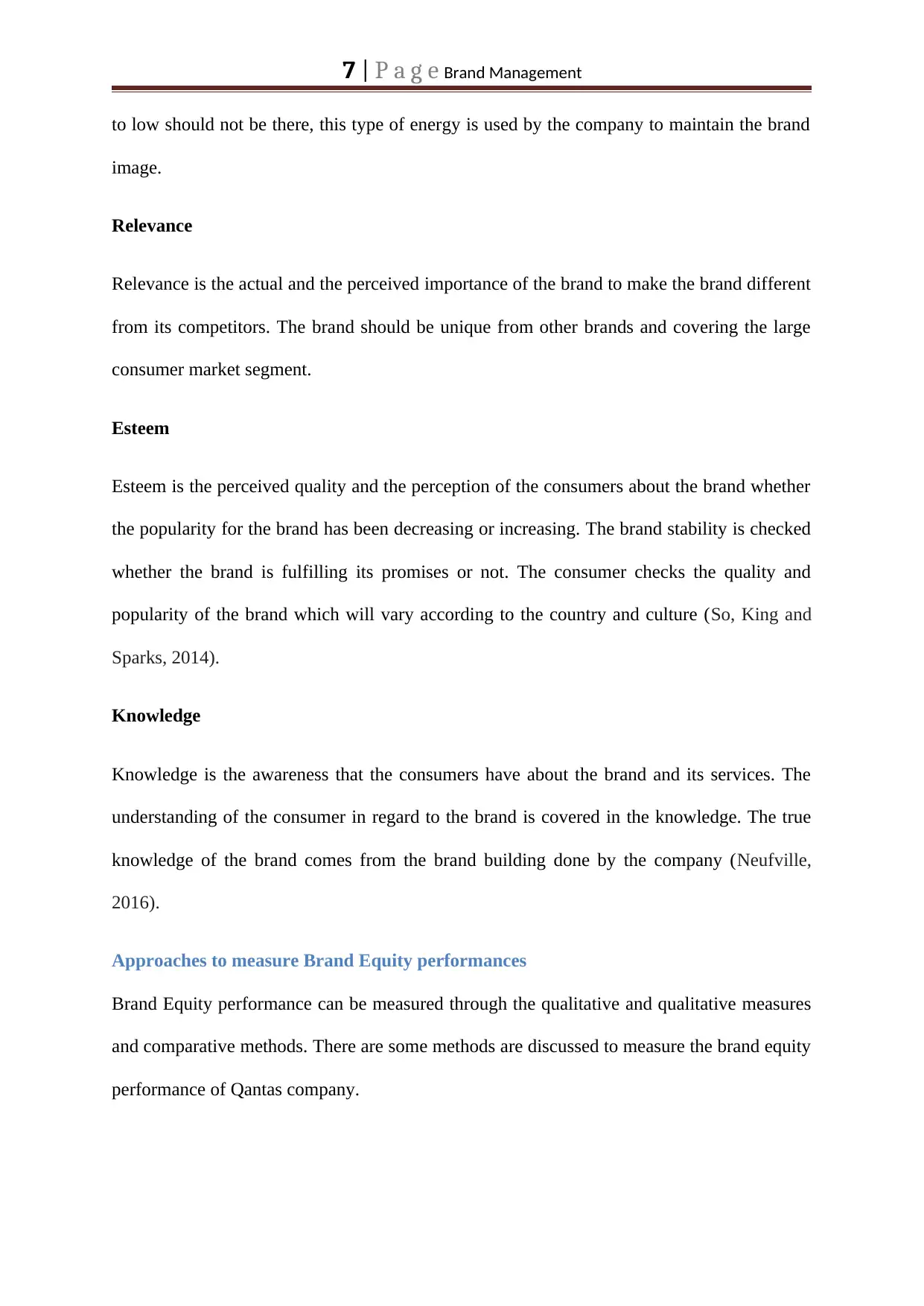
7 | P a g e Brand Management
to low should not be there, this type of energy is used by the company to maintain the brand
image.
Relevance
Relevance is the actual and the perceived importance of the brand to make the brand different
from its competitors. The brand should be unique from other brands and covering the large
consumer market segment.
Esteem
Esteem is the perceived quality and the perception of the consumers about the brand whether
the popularity for the brand has been decreasing or increasing. The brand stability is checked
whether the brand is fulfilling its promises or not. The consumer checks the quality and
popularity of the brand which will vary according to the country and culture (So, King and
Sparks, 2014).
Knowledge
Knowledge is the awareness that the consumers have about the brand and its services. The
understanding of the consumer in regard to the brand is covered in the knowledge. The true
knowledge of the brand comes from the brand building done by the company (Neufville,
2016).
Approaches to measure Brand Equity performances
Brand Equity performance can be measured through the qualitative and qualitative measures
and comparative methods. There are some methods are discussed to measure the brand equity
performance of Qantas company.
to low should not be there, this type of energy is used by the company to maintain the brand
image.
Relevance
Relevance is the actual and the perceived importance of the brand to make the brand different
from its competitors. The brand should be unique from other brands and covering the large
consumer market segment.
Esteem
Esteem is the perceived quality and the perception of the consumers about the brand whether
the popularity for the brand has been decreasing or increasing. The brand stability is checked
whether the brand is fulfilling its promises or not. The consumer checks the quality and
popularity of the brand which will vary according to the country and culture (So, King and
Sparks, 2014).
Knowledge
Knowledge is the awareness that the consumers have about the brand and its services. The
understanding of the consumer in regard to the brand is covered in the knowledge. The true
knowledge of the brand comes from the brand building done by the company (Neufville,
2016).
Approaches to measure Brand Equity performances
Brand Equity performance can be measured through the qualitative and qualitative measures
and comparative methods. There are some methods are discussed to measure the brand equity
performance of Qantas company.
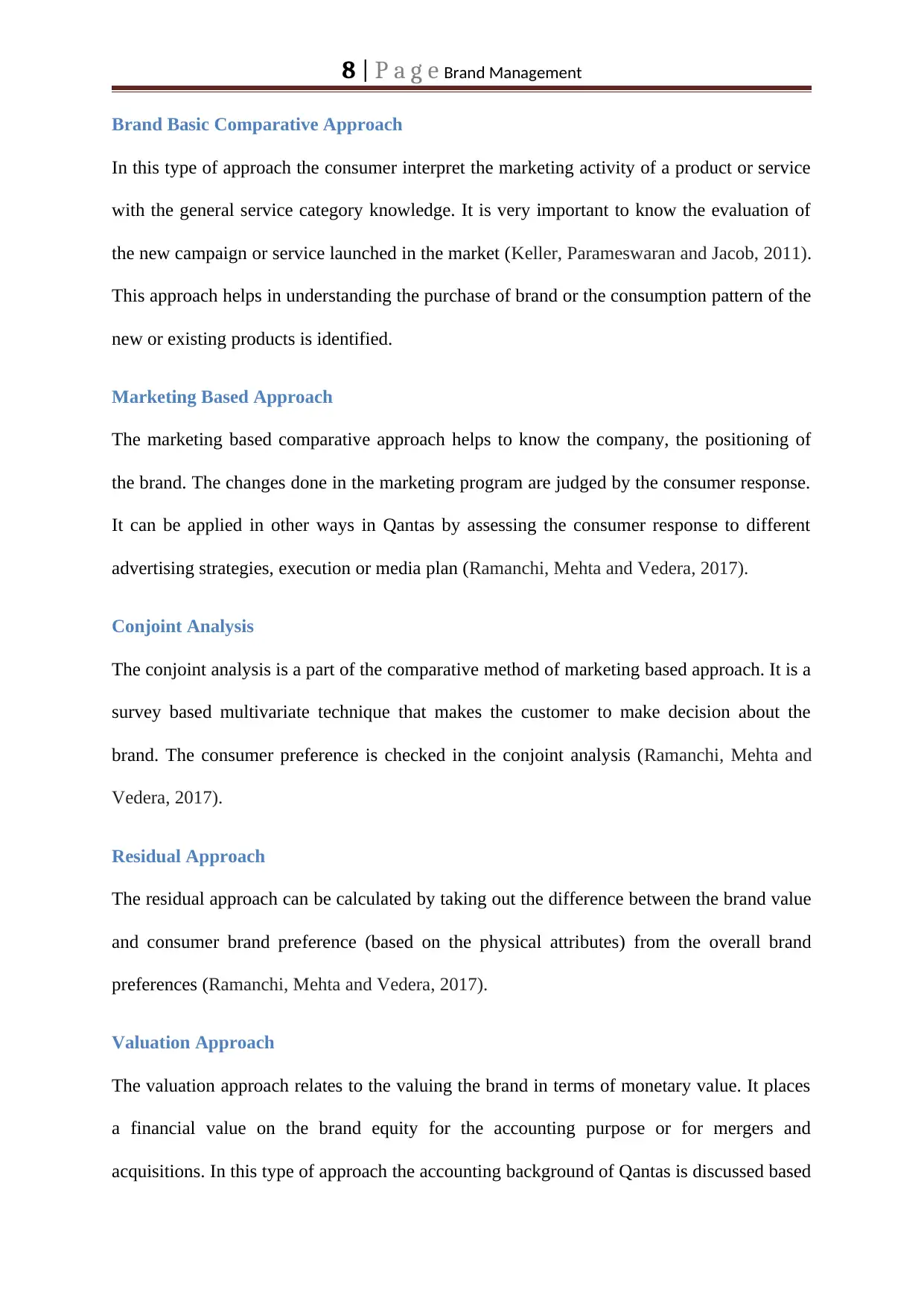
8 | P a g e Brand Management
Brand Basic Comparative Approach
In this type of approach the consumer interpret the marketing activity of a product or service
with the general service category knowledge. It is very important to know the evaluation of
the new campaign or service launched in the market (Keller, Parameswaran and Jacob, 2011).
This approach helps in understanding the purchase of brand or the consumption pattern of the
new or existing products is identified.
Marketing Based Approach
The marketing based comparative approach helps to know the company, the positioning of
the brand. The changes done in the marketing program are judged by the consumer response.
It can be applied in other ways in Qantas by assessing the consumer response to different
advertising strategies, execution or media plan (Ramanchi, Mehta and Vedera, 2017).
Conjoint Analysis
The conjoint analysis is a part of the comparative method of marketing based approach. It is a
survey based multivariate technique that makes the customer to make decision about the
brand. The consumer preference is checked in the conjoint analysis (Ramanchi, Mehta and
Vedera, 2017).
Residual Approach
The residual approach can be calculated by taking out the difference between the brand value
and consumer brand preference (based on the physical attributes) from the overall brand
preferences (Ramanchi, Mehta and Vedera, 2017).
Valuation Approach
The valuation approach relates to the valuing the brand in terms of monetary value. It places
a financial value on the brand equity for the accounting purpose or for mergers and
acquisitions. In this type of approach the accounting background of Qantas is discussed based
Brand Basic Comparative Approach
In this type of approach the consumer interpret the marketing activity of a product or service
with the general service category knowledge. It is very important to know the evaluation of
the new campaign or service launched in the market (Keller, Parameswaran and Jacob, 2011).
This approach helps in understanding the purchase of brand or the consumption pattern of the
new or existing products is identified.
Marketing Based Approach
The marketing based comparative approach helps to know the company, the positioning of
the brand. The changes done in the marketing program are judged by the consumer response.
It can be applied in other ways in Qantas by assessing the consumer response to different
advertising strategies, execution or media plan (Ramanchi, Mehta and Vedera, 2017).
Conjoint Analysis
The conjoint analysis is a part of the comparative method of marketing based approach. It is a
survey based multivariate technique that makes the customer to make decision about the
brand. The consumer preference is checked in the conjoint analysis (Ramanchi, Mehta and
Vedera, 2017).
Residual Approach
The residual approach can be calculated by taking out the difference between the brand value
and consumer brand preference (based on the physical attributes) from the overall brand
preferences (Ramanchi, Mehta and Vedera, 2017).
Valuation Approach
The valuation approach relates to the valuing the brand in terms of monetary value. It places
a financial value on the brand equity for the accounting purpose or for mergers and
acquisitions. In this type of approach the accounting background of Qantas is discussed based
⊘ This is a preview!⊘
Do you want full access?
Subscribe today to unlock all pages.

Trusted by 1+ million students worldwide
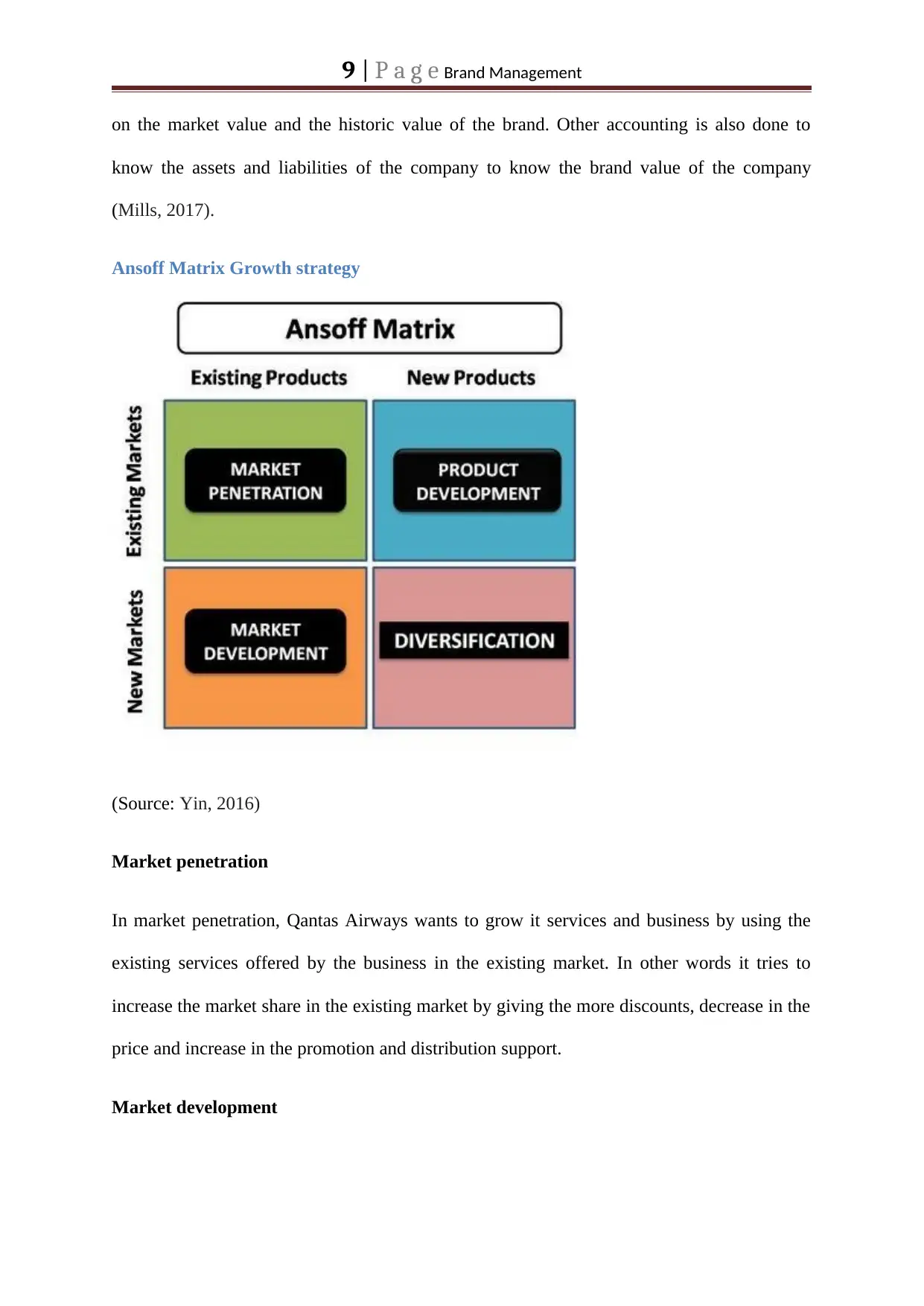
9 | P a g e Brand Management
on the market value and the historic value of the brand. Other accounting is also done to
know the assets and liabilities of the company to know the brand value of the company
(Mills, 2017).
Ansoff Matrix Growth strategy
(Source: Yin, 2016)
Market penetration
In market penetration, Qantas Airways wants to grow it services and business by using the
existing services offered by the business in the existing market. In other words it tries to
increase the market share in the existing market by giving the more discounts, decrease in the
price and increase in the promotion and distribution support.
Market development
on the market value and the historic value of the brand. Other accounting is also done to
know the assets and liabilities of the company to know the brand value of the company
(Mills, 2017).
Ansoff Matrix Growth strategy
(Source: Yin, 2016)
Market penetration
In market penetration, Qantas Airways wants to grow it services and business by using the
existing services offered by the business in the existing market. In other words it tries to
increase the market share in the existing market by giving the more discounts, decrease in the
price and increase in the promotion and distribution support.
Market development
Paraphrase This Document
Need a fresh take? Get an instant paraphrase of this document with our AI Paraphraser
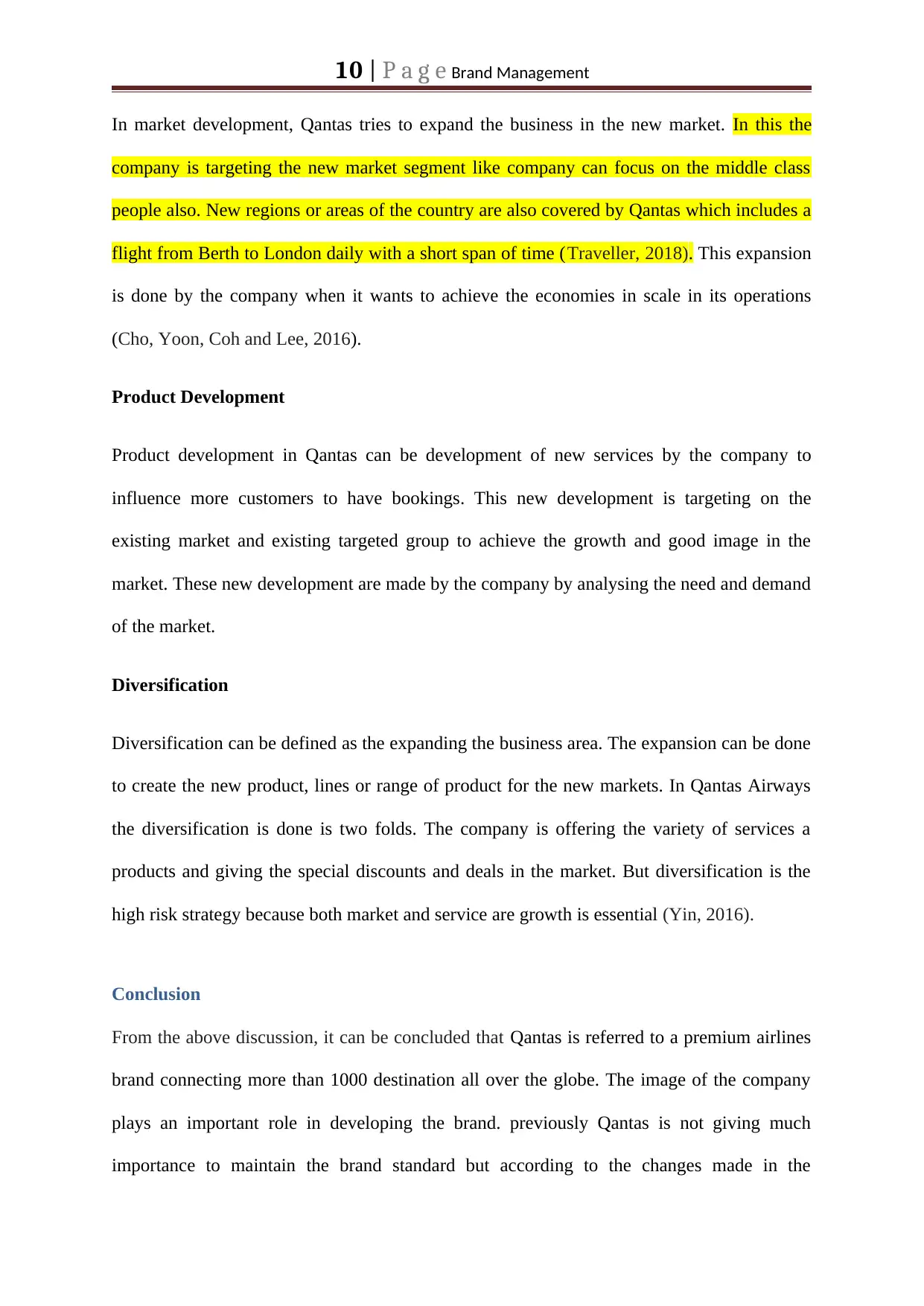
10 | P a g e Brand Management
In market development, Qantas tries to expand the business in the new market. In this the
company is targeting the new market segment like company can focus on the middle class
people also. New regions or areas of the country are also covered by Qantas which includes a
flight from Berth to London daily with a short span of time (Traveller, 2018). This expansion
is done by the company when it wants to achieve the economies in scale in its operations
(Cho, Yoon, Coh and Lee, 2016).
Product Development
Product development in Qantas can be development of new services by the company to
influence more customers to have bookings. This new development is targeting on the
existing market and existing targeted group to achieve the growth and good image in the
market. These new development are made by the company by analysing the need and demand
of the market.
Diversification
Diversification can be defined as the expanding the business area. The expansion can be done
to create the new product, lines or range of product for the new markets. In Qantas Airways
the diversification is done is two folds. The company is offering the variety of services a
products and giving the special discounts and deals in the market. But diversification is the
high risk strategy because both market and service are growth is essential (Yin, 2016).
Conclusion
From the above discussion, it can be concluded that Qantas is referred to a premium airlines
brand connecting more than 1000 destination all over the globe. The image of the company
plays an important role in developing the brand. previously Qantas is not giving much
importance to maintain the brand standard but according to the changes made in the
In market development, Qantas tries to expand the business in the new market. In this the
company is targeting the new market segment like company can focus on the middle class
people also. New regions or areas of the country are also covered by Qantas which includes a
flight from Berth to London daily with a short span of time (Traveller, 2018). This expansion
is done by the company when it wants to achieve the economies in scale in its operations
(Cho, Yoon, Coh and Lee, 2016).
Product Development
Product development in Qantas can be development of new services by the company to
influence more customers to have bookings. This new development is targeting on the
existing market and existing targeted group to achieve the growth and good image in the
market. These new development are made by the company by analysing the need and demand
of the market.
Diversification
Diversification can be defined as the expanding the business area. The expansion can be done
to create the new product, lines or range of product for the new markets. In Qantas Airways
the diversification is done is two folds. The company is offering the variety of services a
products and giving the special discounts and deals in the market. But diversification is the
high risk strategy because both market and service are growth is essential (Yin, 2016).
Conclusion
From the above discussion, it can be concluded that Qantas is referred to a premium airlines
brand connecting more than 1000 destination all over the globe. The image of the company
plays an important role in developing the brand. previously Qantas is not giving much
importance to maintain the brand standard but according to the changes made in the
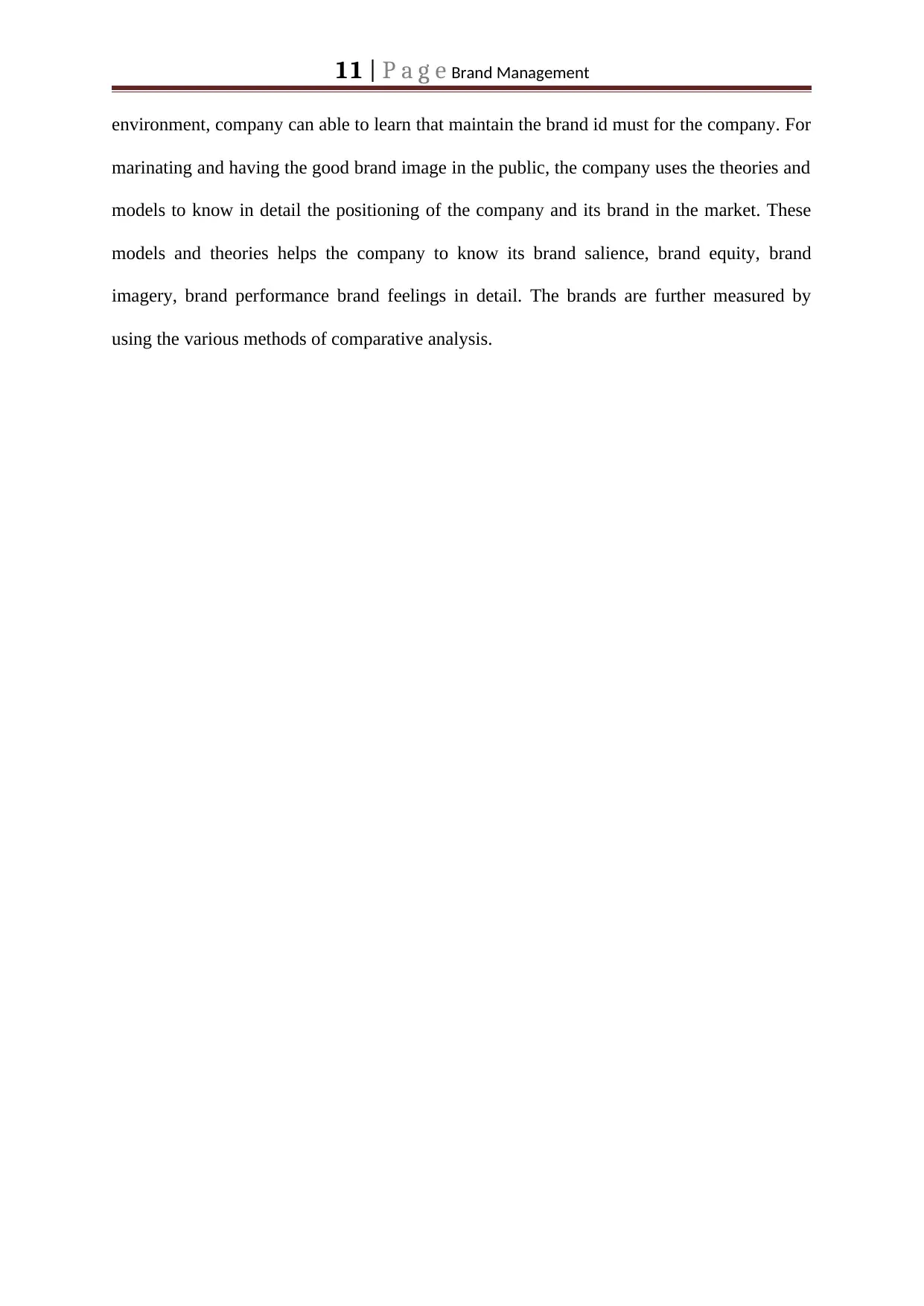
11 | P a g e Brand Management
environment, company can able to learn that maintain the brand id must for the company. For
marinating and having the good brand image in the public, the company uses the theories and
models to know in detail the positioning of the company and its brand in the market. These
models and theories helps the company to know its brand salience, brand equity, brand
imagery, brand performance brand feelings in detail. The brands are further measured by
using the various methods of comparative analysis.
environment, company can able to learn that maintain the brand id must for the company. For
marinating and having the good brand image in the public, the company uses the theories and
models to know in detail the positioning of the company and its brand in the market. These
models and theories helps the company to know its brand salience, brand equity, brand
imagery, brand performance brand feelings in detail. The brands are further measured by
using the various methods of comparative analysis.
⊘ This is a preview!⊘
Do you want full access?
Subscribe today to unlock all pages.

Trusted by 1+ million students worldwide
1 out of 20
Related Documents
Your All-in-One AI-Powered Toolkit for Academic Success.
+13062052269
info@desklib.com
Available 24*7 on WhatsApp / Email
![[object Object]](/_next/static/media/star-bottom.7253800d.svg)
Unlock your academic potential
Copyright © 2020–2025 A2Z Services. All Rights Reserved. Developed and managed by ZUCOL.





